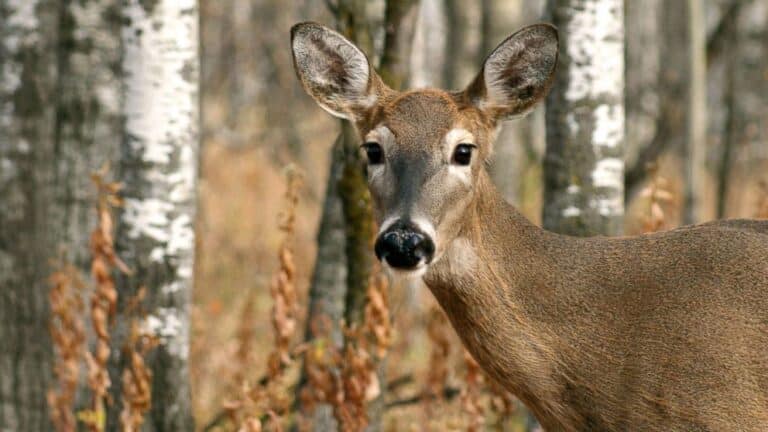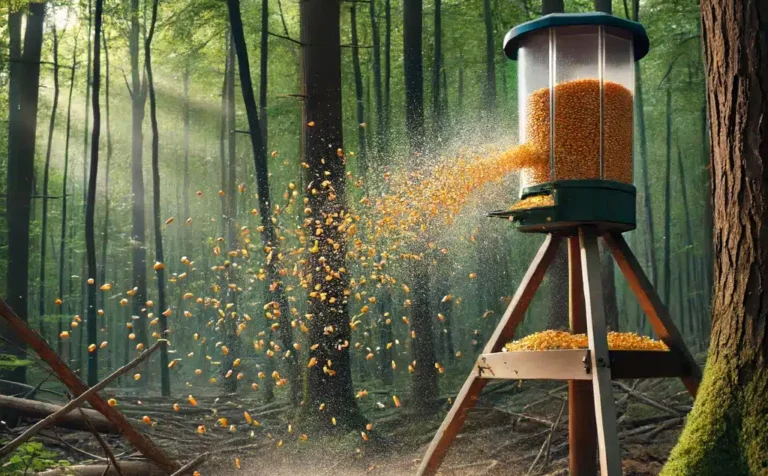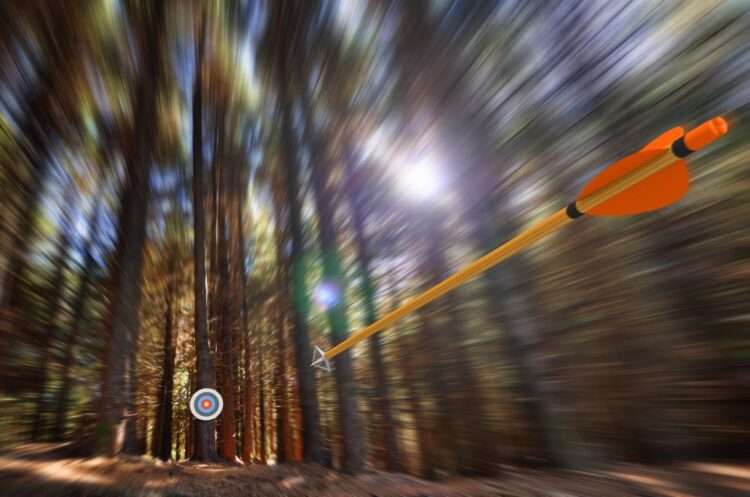As an avid hunter, you may be familiar with the fallow deer (Dama mesopotamica), which boasts unique features and behaviors. This European fallow deer is recognized by its broad antlers and diverse coat colors ranging from white to dark brown.

In this blog post, we will delve into the distinctive characteristics of fallow deer, comparing their footprints with other deer species for better identification in the field. We’ll trace back the historical distribution of these creatures – from their origins as Persian Fallow Deer (Dama Mesopotamia) to how British colonialism influenced their global spread.
We’ll also explore how modern introductions have impacted ecosystems across North America and beyond, including potential disease transmission risks posed by introduced populations. The habitats preferred by Fallows, along with their lifestyle patterns, will be examined in detail.
Finally, we’ll conduct a comparative analysis between various deer types and discuss resources available for understanding better conservation efforts towards preserving this intriguing species. Prepare to embark on a fascinating journey through the world of fallow deer!
Understanding Fallow Deer
Fallow deer are fascinating creatures with unique characteristics that set them apart from other deer. These medium-sized mammals are easily recognizable thanks to their spotted coat and twitching tail, which doubles as a built-in alarm system in the wild.
Spotting the Standout Features of Fallow Deer
The most eye-catching feature of fallow deer is their broad, shovel-like antlers. Unlike other deer species, their antlers lack points or tines, giving them an advantage when males compete for mates during the rutting season.
Fallow deer boast a variety of colors, including white, black, and most typically, an amalgamation of brown spots in the summertime that transitions into an unpatterned grayish-brown during winter – providing them with camouflage to remain hidden from potential predators or hunters. This color change helps them blend in with their surroundings and stay hidden from predators like wolves or hunters.
Comparing Footprints: Fallow Deer vs. Others
One exciting way to identify fallow deer is by examining their footprints. They leave hoof prints similar to sika deer, but there’s one key difference: heart-shaped white markings on their tails. While tracking them can be challenging due to their excellent camouflage skills, sharp-eyed observers may spot these signs indicating their presence nearby.
In addition to visual cues, fallow deer also have a unique vocalization. During the rut, bucks produce groaning sounds, while does make bleating noises, especially when communicating with their fawns. And if they’re alarmed, you might even hear them bark. So, keep your eyes (and ears) open when exploring the wilderness.
At DeerDonkey.com, we believe in hunting and displaying our mission. We’re committed to educating people about mammal species, including fallow deer. These majestic animals hold significant historical importance but face modern challenges due to habitat changes and disease spread. We hope this insight helps you better recognize and appreciate these beautiful creatures, whether observing wildlife or working on your next fallow deer project.
Historical Distribution of Fallow Deer
The fallow deer, known for its unique characteristics and color variation, has a rich European history. This deer species has roamed the English countryside since ancient times, leaving heart-shaped white markings on their tails.
Tracing the Origins and Spread of Fallow Deer
Fallow deer originated in Asia Minor and spread across Europe during the Pleistocene era. The Romans introduced them to Britain for hunting around 1 AD. Thanks to human transportation practices, these creatures have become widely distributed globally. Hunters abound and look forward to their mating season.
Over 8,000 years ago, humans transported fallow deer from their native habitats to different parts of the world as game animals. Today, they’re one of the most widely distributed deer species.
The Role of British Colonialism in Global Distribution
During British colonial times, settlers brought familiar wildlife, including fallow deer, to new territories as part of “acclimatization” efforts. The introduction of fallow deer through British colonialism has had a lasting impact, resulting in populations now found in countries such as Australia, New Zealand, South Africa, and the United States. Despite pests that damage young trees, fallow deer have adapted well to diverse landscapes, including urban environments.
It’s fascinating how the impacts of these introductions continue to shape ecosystems worldwide. Britannica provides more insights into the global distribution of fallow deer.
Modern Introduction and Impact on Ecosystems
Fallow deer have been introduced to new regions like the United States from Europe. Good intentions, dire consequences.
Analyzing ecological impact after introduction
Fallow deer, typically dark brown, have wreaked havoc on local ecosystems. The ravenous feeding habits of fallow deer have caused overgrazing, environmental damage, and reduced biodiversity. It’s a gluttonous feast for all vegetation types, with unintended consequences.
These non-native deer also mess with food chains, out-competing native wildlife and becoming unexpected prey. It’s like a game of chance with no set rules, with high stakes.
Disease transmission risks from introduced populations
Not only do fallow deer mess with habitats and food chains, but they also spread diseases like Chronic Wasting Disease (CWD). It’s like a bad case of contagious cooties.
CWD affects cervids like elk, moose, and now potentially fallow deer. It’s a severe threat to individual and population health. To fix the mess caused by fallow deer, we need to understand their behavior and take conservation measures. Let’s coexist sustainably, folks.
Habitats & Lifestyle Patterns
Fallow deer: masters of adaptability. They can live in open woodlands or parklands, forming small herds of 10 to 50 animals. Talk about social distancing. But get them near mating season or, as my English friend calls it, the breeding season; they become ‘buck wild’!
Examining the preferred hangouts of Fallows
Fallow deer love open woodlands and parklands. It’s like their version of a luxury resort – plenty of cover from predators and delicious grazing opportunities. They’re not picky eaters.
These deer can even thrive in commercial forestry settings. They’re like the MacGyvers of the animal kingdom, making it work wherever they go. Yet, obstacles arise in such circumstances.
Adapting behavior like a boss
Fallow deer are adaptable AF. In dense forests or commercial plantations, where visibility is low, they become nocturnal creatures. Night owls, literally.
- Grazing habits: Fallow deer are grass connoisseurs in the summer, but they switch to browsing (leaves, shoots, bark) in the winter. They’re all about that seasonal menu.
- Pest problems: These survivors can be a real pain in the trunk. In commercial forestry settings, they munch on young trees like they’re at an all-you-can-eat buffet—time to call in the tree protectors.
Understanding Fallow Deer’s habitats and lifestyle patterns is crucial for hunters and conservationists. It’s all about balancing respecting their adaptations and minimizing the impact. Let’s keep exploring together.
Distinguishing Features Between Various Deer Types
- Fallow Deer: With broad antlers and a spotted coat, fallow deer have heart-shaped white markings on their tails. They’re easily recognizable by these tail markings.
- Red Deer: These large mammals have a reddish-brown coat that turns grey in winter. Unlike other deer types, they have visible tails and buff-colored rumps. They also prefer all vegetation types.
- Roe Deer: Smaller than red and fallow deer, they lack visible tails, making them easy to distinguish. Their coats vary from greyish brown in winter to rich reddish brown in summer.
- Sika Deer: Native to East Asia, Sika deer have pointed antlers and a distinctive white heart-shaped rump. Click here for more details on Sika deer.
Each deer species, including Fallow Deer, Red Deer, Roe Deer, and Sika Deer, has unique features that set it apart. Understanding these differences is essential for hunters, as it helps with identification and hunting strategies. By respecting nature’s diversity, we can ensure successful outcomes without disrupting the balance within ecosystems. Conservation Efforts & Management Strategies
In the modern era, fallow deer face challenges due to habitat changes and disease spread. Their breeding season keeps getting shorter. At DeerDonkey.com, we’re all about responsible hunting and preserving wildlife. Let’s educate ourselves about these pressing issues.
Resources for understanding better conservation efforts
Check out the Mammal Society Mini Course for insights into sustainable management strategies. It’s about fallow deer and other historically significant mammal species.
Education is critical for hunters to maintain ecosystem balance. By learning about different species, hunters can make informed decisions contributing to biodiversity conservation.
Fallow deer are adaptable, but they’ve become invasive pests in some regions. Well-planned hunting can be an effective management strategy, controlling population sizes and minimizing environmental damage.
- Habitat Conservation: Protecting natural habitats is crucial for sustaining healthy wildlife populations, including fallow deer. Let’s limit urban development encroachment, implement reforestation programs, and manage human-wildlife conflicts effectively.
- Disease Control: Diseases pose significant threats, especially when non-native animals introduce new pathogens. We must promptly identify outbreaks and respond appropriately for containment or eradication.
- Sustainable Hunting Practices: Responsible hunting is key. Let’s respect local laws, use humane methods, and minimize disturbance to non-targeted animals. By reducing overall stress levels, we contribute to their well-being too.
FAQs about Fallow Deer
What makes fallow deer so unique?
Fallow deer are known for their unique palmate antlers, spotted coats, and various color variations. They have quite a fascinating history, having been introduced globally during the British colonial era. Learn more.
Why are fallow deer considered a problem?
Introducing fallow deer in non-native regions has caused ecological imbalances, as they compete with native species and pose risks of disease transmission. Find out more.
Why are they called fallow deer?
The term ‘fallow’ comes from Old English ‘feel,’ which means pale yellow or light brown, describing the standard coat color of these animals.
How do fallow deer impact the environment?
Fallow deer can alter vegetation structure through overgrazing, compete with native wildlife for resources, and potentially spread diseases.
Conclusion
Understanding fallow deer is crucial for hunters because, let’s face it, mistaking them for other species would be embarrassing.
By comparing footprints and recognizing their distinctive features, hunters can confidently identify fallow deer in the wild and avoid awkward encounters with other hunters who know what they’re doing.
Tracing back their historical distribution reveals the fascinating role played by the British colonial era in spreading these deer worldwide, which is like a real-life game of “Where in the World is Carmen Sandiego?” but with deer.
Studying fallow deer’s modern introduction and impact on ecosystems is educational. It helps hunters understand the potential risks of disease transmission because nobody wants to bring home a souvenir with a side of illness.
Examining their preferred habitats and lifestyle patterns is like getting a sneak peek into the secret lives of fallow deer. It allows hunters to adapt their strategies accordingly because deer are pretty sneaky.
Lastly, comparative analysis with other species provides valuable insights into the distinguishing features between various types of deer because knowledge is power. In this case, it’s the power to impress your fellow hunters with your deer identification skills.






